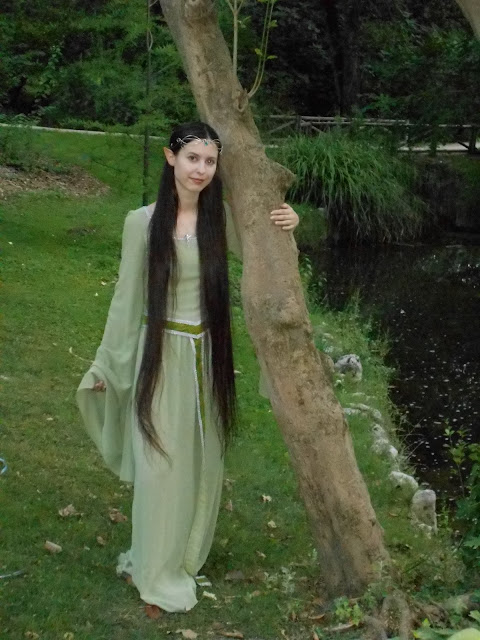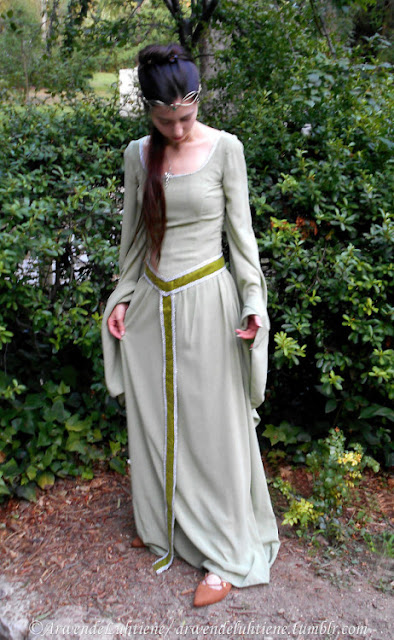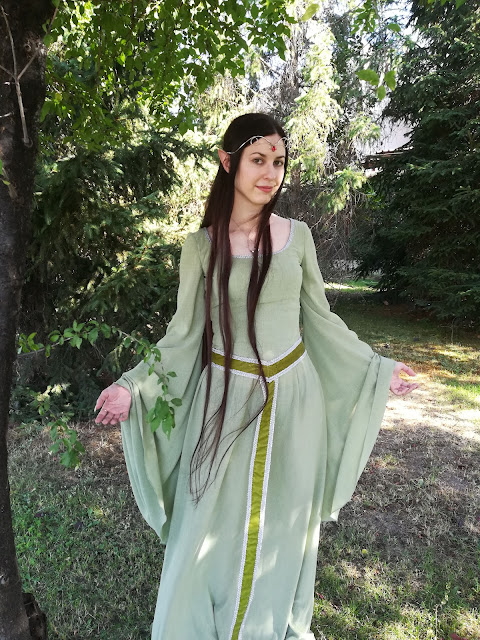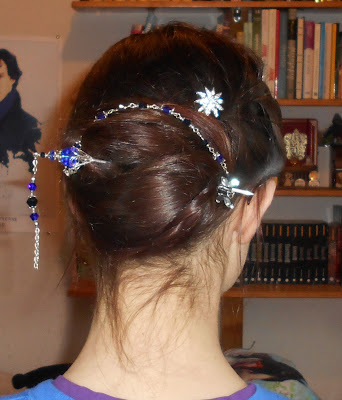A henna post at last 😃💖! I've been wanting to post about my henna adventures on here for a while, adventures which started in 2010-11 and then again in 2019 until today, after a Manic Panic experiment in 2013 and a long hiatus after that. So starting from the very end, here's my 2022 henna'ings!
But before going for the pic spam 🤩, here's some basic info about my henna'ings:
✨Why do I henna? Benefits of henna for me✨
Primarily it's for the colour, I love red hair and always strive for it 💖 xD And henna is one of the best herbal hair dyes for that, as it gives various shades of red (or browns and blacks, if combined with other herbal dyes such as amla, indigo or walnut). My starting (natural) hair-colour is a dark auburn (it used to be a light auburn when I was little, but it darkened over time), with copper and red highlights, and also blond hair at the temples (with an increasing amount of greys especially at the temples that I started having in my teenage years welp 😅). The henna molecule in the dye (lawsone) acts by coating the hair shaft and binding itself to the hair proteins (keratin), so it's not only a permanent dye with little-to-no fading (although the vibrancy can diminish over time, without further applications), but it is also only able to enhance and darken the colour - so this means that you can't achieve a lighter shade than the one you're starting with.
 |
| Source: Henna For Hair |
This is why even when using a mix of henna and cassia (a mostly colourless hair mud that can enhance golden tones), a mix that would dye light hair-colours into copper, my final henna colour is normally rather a warm mahogany red and not a fiery copper red - except for the ends, the blond temple hairs and the greys (welp), where the colour does range from a fiery copper to true red, depending on the henna/cassia ratio and the type of henna (which can give a more orangey red, a true red, or a burgundy red).
Henna is also really good for my hair in quite a lot of ways, something which massively outweights the rather hard and messy work of applying this hair mud to all my roots every two months 🤣. Chemical permanent dyes (the conventional box dyes) which usually contain harsh ingredients like peroxide, alcohol and PPD, which tend to be irritating and harmful to the hair, and I personally have always evaded these box dyes (if chemical hair dyes work for you, kudos, though!). I use some alcohol-based hairsprays and such sporadically, with no overtly harmful results, although prolongued use of anything that contains peroxide, alcohols or other similar agents will surely harm the hair, causing breakage, brittleness and/or dryness.
In contrast, henna and other herbal hair muds (make sure boxed hennas don't include iron sulfates, though!) tend to offer plenty of hair benefits as well as hair colouring, nourishing, strenghtening and protecting hair in various ways, which is for me a win/win situation 😃. Henna penetrates the hair shaft, strengthening the follicles and making the hair more resistant to breakage, with many people reporting that henna makes their hair thicker or denser over time, as well. Henna also smoothes the hair cuticle, enhancing shine and softness, promotes hair growth and reduces shedding, and its astringent tannins cleanse out the scalp, treat greasy roots and dandruff, and also have anti-fungal and anti-bacterial properties.
In my case, henna really helps to throroughly clean my scalp (with low-porous fine-textured hair and a routinely use of dry shampoo throughout the week, I tend to get build-up easily), and it combats my tendency for greasy roots. With continuous use, I also think that my fragile, fine-texture hair is stronger, and my hair definitely feels a bit denser just after a henna application, although I'm not sure how much denser it actually is on a normal basis compared to before using henna routinely (I think it's definitely a bit denser than before using henna as part of my hair routine). Also, my hair is normally shiny and soft without me doing anything because of its very fine texture (that's the pro to my prone-to-build-up and staticy-af con xD), but henna definitely boosts the shine and softness as well ✨.
Sounds like it's all pros, although bear in mind that some people have also reported itchy scalp reactions to hair muds, or temporary dryness and/or coarseness after the henna applications. In my case, my scalp notmally itches a bit the first couple of days after each henna'ing because of the remaining dried crumby henna in my scalp that the shower rinsing didn't manage to get off (with practice no large bits will be left in the hair, though xD). For me it's a mild itchiness that soon disappears, but some people may have an allergic reaction to some of these herbal muds, so it's always useful to do a test beforehand on your arm.
Also in my case, henna doesn't dry out my hair or make it coarser after an application. Like I said above, in my specific case henna helps a lot with my oily roots and my length and ends don't tend to get dry as a rule, and henna doesn't affect them either (which is why I don't use conditioners in my hair routine and only use oils very sparingly, because my low-porous fine-textured hair doesn't like heavy products and build-up is an issue). But some people may need to deep condition after henna'ing to avoid dryness and coarseness (which should also get better a few days after the application). I sometimes use a little bit of conditioner in my length when rinsing out the henna, but it's mainly to aid in the detangling, rather than to combat any dryness from the henna (particularly so when I'm only retouching my roots).
✨How often do I use henna?✨
The last time I henna'ed my entire head of hair was February 2022, and since then what I've done is a complete root touch-up every two months. I sometimes redo my temples in-between those root retouches, because my hair grows quite fast. Because henna is a permanent dye, the colour stays without washing off, although it does lose some of its vivid sheen over time, often depending on the brand and freshness of the henna used. This is why some henna heads do glosses in between full henna'ings, getting back that vivid henna sheen without darkening the colour by mixing a small amount of henna with cassia or other colourless moisturizing product, like yoghurt. I haven't really done more than root touch-ups for now, though. Although I may do a gloss sometime in 2023 for the length. I doubt I will do a full henna'ing any time soon, as continuous applications will make the colour steadily darker, which I don't want 😅.
✨Which brands of henna do I use and how do I make the mud mixture?✨
The two main brands of henna that I use are firstly Khadi henna (the 'Pure Red' shade, which is just henna), which I have used both on its own (especially back in 2020), and as part of a mix with cassia in a 60% henna 40% cassia ratio (to achieve a lighter, more copper shade, rather than true red tones); and secondly, the Radhe Shyam mahogany shade, which in the one that I've mainly used this year. This premade henna mix includes both henna and cassia as well as a bit of sodium picramate, the sodium salt of picramic acid, an acidic colour fixator. Some people really dislike this ingredient, and I definitely agree that it can be quite misleading to advertise a henna mixture as 'just henna' when it actually has more 'chemical' additives. However, personally, I don't mind it, and it's safe for hair in small quantities.
Addendum - I also don't agree with the 'anything that isn't 100% "natural" is bad for your hair as a rule' discourse, to be honest. While there are a lot of artificial 'chemical' ingredients in hair products that can be objectively bad for the hair and/or body (causing dryness and irritation in even small doses, not posing any benefits to the hair, even being potentially carcinogetic ingredientes, etc), sometimes with certain ingredients which don't pose an outright negative/dangerous effect to the hair and body, it's all about the quantity of it in the whole mix, such as in this case (I get all the benefits of the henna and cassia with a little bit of added fixator, which doesn't irritate or harm my scalp or disrupt my henna experience in any way, if anything it adds to it). And there are also 100% natural things such as cinnamon or lemon which can be important scalp irritants and quite drying for the hair, and so their use is often not recommended in haircare (don't put cinnamon in your hair because it will probably irritate/burn your scalp big time :S!). So we need more subtely in that discourse, for sure.
Not anything that is "100% natural" is good for your hair, and not all "chemical"/artificial additives are necessarily incredibly bad for your hair. Quantities and dosage are also pretty important factors, as is each head of hair and its needs - My hair needs a bit of sulfates in my shampoo to clean my oilier roots. for example, but just one 'SLS' (Sodium Laureth Sulfate) in the ingredients will do, while a shampoo that has like 3-4 different 'SLS' types in it proves to be overly harsh and contains an unnecessary large amount of sulfates for no reason at all. Similarly, my fine-textured hair doesn't tolerate silicones and doesn't need them to stay smooth and moisturized, so I don't use conditioners, but other hairtypes swear by a bit of silicone in their hair to make it smoother and combat dryness. A sporadic/controlled use of fixator products with alcohol in them, such as traditional hairspray, can pose no particular harm to certain hairtypes (my oily-prone scalp doesn't dry out if I use hairspray sporadically for cosplay, for example, and the length and ends recuperate quickly with a nightly oil leave-in), while other hairtypes would suffer dryness from alcohol-based products instantly.
I started this hair blog with the motto of 'natural haircare' because I do believe that many hair products contain an overly large amount of unnecessary artificial ingredients that do not benefit the hair, and I do stand by the fact that herbal haircare (henna and aryuvedic haircare, aloe vera, herbal-based shampoos, etc) is incredibly beneficial (other factors in this motto of 'natural haircare' for me would include forgoing heat products and so on). But I also use a bit of sulfate in my shampoo, a bit of sodium picramate in my henna mixes depending on which henna I'm using, and go for an sporadic use of alcohol-based products to style my hair, and that's OK too. So it does vary a lot on more factors than just 'natural=good' and 'artificial=bad'. And there's a culture of forgoing all subtlety with this discourse sometimes, and shaming those people who choose to use sulfates, silicones and so on, which is not OK - even if one disagrees, their hair, their choice.
How
much henna you will need depends on how long and thick your hair is,
and whether you will dye your whole length or just do a root touch-up. For the whole root touch-up I generally just need half a box (approx. 50 g - be it 50g of the Radhe Shyam mahogany mix, or a customized mix of approx. 30g of henna and 20g of cassia). For the whole head of hair (fingertip-to-mid-thigh F ii/iii hair), I generally use approximately short of two boxes (up to 200 g; one time I used 200 g of henna vs 150 g of cassia for the whole head of hair, but it was a bit too much).
✨Henna application✨
 |
| Henna all set up for root retouching! Radhe Shyam Mahogany, in this case, mixed with warm water and a couple spoonfuls of apple cider vinegar. |
I mix the henna powder with hot water (it's generally thought to be better that it isn't boiling hot, though), with a couple of tablespoons of apple cider vinegar as an acidic factor to help with the dye release and make the colour redder and brighter. Both heat and acidic liquids help release the dye, allowing for the lawsome dye molecule to migrate out of the mud mixture faster. In the past I used squeezed lemon juice, but this year I switched to apple cider vinegar as lemon is too acidic and can be harsh for the scalp. Some people also report that adding lemon makes the henna dye darker, which is not my goal.
Many henna heads further let the mixture sit for a while, from a couple of hours to overnight, so that the dye releases fully. I have tried this as well, but personally I already get a decent dye release with the combination of hot water and the apple cider vinegar, so I tend to apply the mixture to the hair shortly after preparing the mix, while it's still warm. In the past I also used to make a strong infusion of red tea or hibiscus for a boost of red, but while tea rinses are great for my scalp and hair, the actual effect of these infusions as red dyes are practically negligible, so lately I've been just using hot water.
I apply the henna mud evenly to the hair, starting with the roots (and continuing with the length, if I'm doing the whole head of hair), adding more warm water as needed to keep the mix warm and with the right consistency. Then I pile the hair on my head, cover it with a plastic shower cap, and add tin foil and a towel to keep it warm, which helps with the dye release and prevents the henna mud from drying out. I let the henna sit for approximately 2 hours, sometimes also applying heat from time to time with the blow dryer. Meanwhile I clean up all the mess from the application process 😅 😂 (with practice and if I'm just retouching the roots, this mess is much more manageable xD). After the 2 hours, it's rinsing it all out patiently in the shower (the mess is real, but the henna mud also dissolves into the water pretty easily, so cleaning the shower is easier than it looks at first xD). Henna also acts as a shampoo and cleans out the scalp, so there's no need to shampoo your hair when you henna, I sometimes don't and I sometimes apply a little bit to help remove the remaining henna dust and avoid the temporary itchiness. I also sometimes apply a bit of conditioner to the length to help with the detangling process, and done!
✨And now for the 2022 bi-monthly henna'ings and the pic spam 😄✨
Get ready for a lot of silly pics during and after the henna application 🤣👍!
- February 2022: The only time I henna'ed both roots and length this year. I used 200 g (two boxes) of the Radhe Shyam mahogany henna+cassia.
The silly pics start 🤣
Henna sheen 💖 the day after, direct and indirect midday sunlight the day after henna'ing (also on Instagram here). While
the result of my henna'ings are lately closer to true
red/burgundy highlights than my preferred copper red highlights in many lightings, the henna still glows copper in certain lightings, and especially with direct sunlight backlighting. One of the great things about henna for me is the sheen, for sure. Even if your hair isn't as bright red overall as you would like because of your starting colour, there's so many shades of red as 'henna sheen' and highlights depending on the lighting 😍!
Temples are always particularly red, it's pretty much the actual copper of the henna 😄
- From now on it's root touch-ups (April, June, August and October), with about 50 g of Radhe Shyam mahogany henna (half a box).
Silly pics from April and August 2022 touch-ups -
- June 2022: Henna sheen over dark auburn hair just after henna'ing, indirect afternoon sunlight (and bonus direct sunlight the next day) ✨(on IG here and here). Most pics shows a warm mahogany red (which I really like in these pics!), but in some lightings there's also the copper sheen in backlit indirect sunlight:
A couple of length shots from June in direct/indirect sunlight:
- September 2022, temples retouch:
- October 2022 root touch-up, again featuring henna sheen in direct sunlight, with
a half-flipped bun and side braids (on IG):
And bonus silly pic, of course 😂:
November shot where you can really see the contrast of the bright copper hair at the temples (and my right temple streak, which I'm fully embracing):
And also a November length shot during an Elven cosplay shoot, outdoor lighting just after the Sun set:
And finally, late December 2022, my last root touch-up of the year. Featuring silly pics (gotta love those xD), and henna sheen in direct and indirect sunlight (indoors), and bathroom lighting (on IG):


















.jpg)





























.png)
